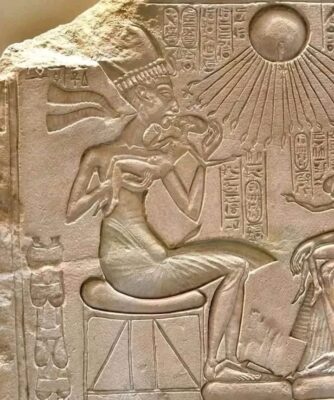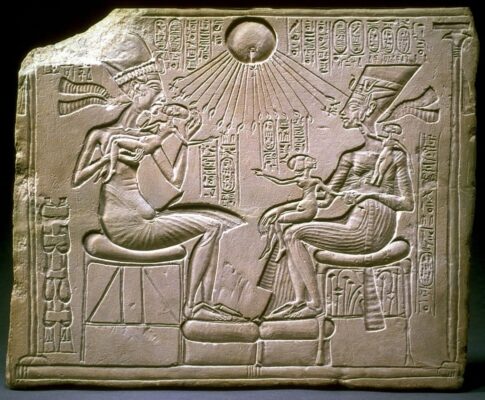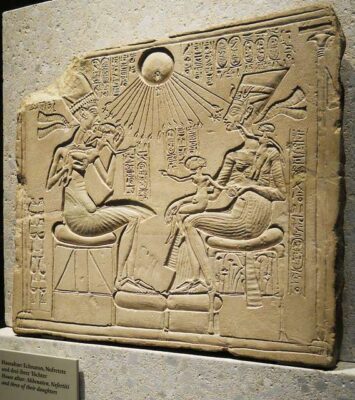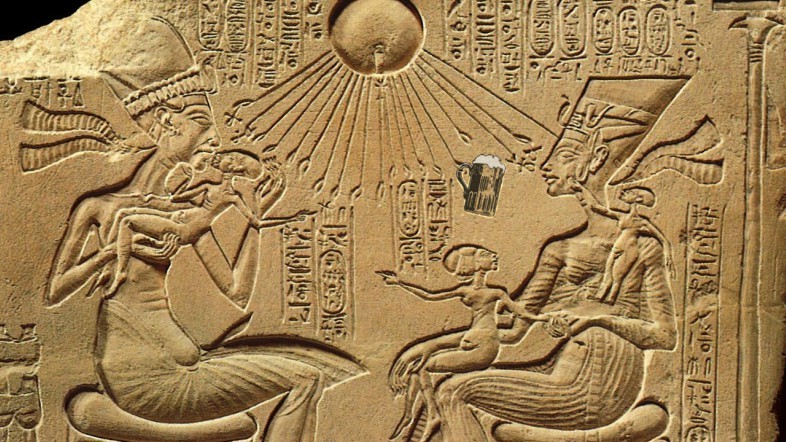Akhenaten and His Daughter, one of the most fascinating pharaohs of Ancient Egypt, captured in a stunning artifact, provide insight into the culture and family life of Egypt’s New Kingdom. This sculpture, dating back to around 1345 BCE, represents not only the personal life of the pharaoh but also a significant moment in Egypt’s artistic evolution during the 18th Dynasty. Follow archeology.dulichvn.net to discover many hidden mysteries that have yet to be discovered.

The Historical Context of Akhenaten
A Revolutionary Pharaoh
Akhenaten, initially named Amenhotep IV, is most renowned for his radical religious reforms, where he shifted Egypt’s longstanding polytheistic beliefs to the exclusive worship of Aten, the sun disk. This groundbreaking change had far-reaching consequences, not only altering Egypt’s religious landscape but also affecting its political structure and artistic expression.
The Amarna Period: A Time of Artistic Transformation
The reign of Akhenaten heralded the start of the Amarna Period, a transformative era in Egyptian history known for its bold artistic innovation. During this time, Egyptian art saw a dramatic departure from its traditional stylized depictions, embracing more naturalistic representations of the human form. Akhenaten’s reign introduced a distinct visual language that broke from centuries of established artistic norms.
Akhenaten’s Enduring Legacy
Although Akhenaten’s religious reforms were met with resistance and ultimately undone by his successors, his influence on Egyptian art and culture remains undeniable. His reign, marked by attempts to reshape religion and society, is remembered for its unique artistic style and personal dynamics, providing crucial insight into his complex rule. The legacy of Akhenaten, from his revolutionary ideas to his extraordinary family life, continues to shape our understanding of Ancient Egypt.

The Sculpture of Akhenaten and His Daughter
A Rare Artistic Insight
This sculpture, discovered in Amarna, offers a glimpse into a rare and tender moment between Akhenaten and one of his daughters. Unlike traditional depictions of pharaohs as distant, god-like figures, this artwork captures a more personal, intimate side of Akhenaten’s family life, highlighting his role as a loving father.
The Shift to Naturalism
The figures in this sculpture are crafted with a naturalistic style, a hallmark of the Amarna period. Akhenaten’s elongated face and distinct features, along with the lifelike portrayal of his daughter, exemplify the period’s departure from idealized representations, embracing a more human and relatable depiction of the royal family.
Symbolism of Family and Leadership
Beyond the naturalistic style, this artwork carries deep symbolic meaning. The tender connection between father and daughter emphasizes Akhenaten’s dual role as both a ruler and a devoted family man. This intimate portrayal reinforces the importance of familial bonds in his reign, offering insight into the personal dynamics that shaped his leadership and governance.

The Artifact’s Journey to the Neues Museum
Unearthed in Amarna
The sculpture was discovered in the ancient city of Amarna, the capital founded by Akhenaten during his religious revolution. Amarna, now a key archaeological site, provides invaluable insight into Akhenaten’s brief but transformative reign, making this discovery all the more significant.
The Role of the Neues Museum
Currently displayed at the Neues Museum in Berlin, Germany, the sculpture is part of the museum’s renowned Egyptian collection. As one of the most important artifacts in the museum, it attracts visitors from around the globe, eager to witness its historical and artistic significance.
A Glimpse into Ancient Egyptian Life
This sculpture offers a rare glimpse into the personal life of Akhenaten, one of Egypt’s most controversial pharaohs. It also captures the profound artistic and cultural shifts that occurred during his reign, making it an essential piece for understanding the evolution of Egyptian art and royal life.
See more: The Lovers of Valdaro: A 6,000-Year-Old Testament to Ancient Love
Conclusion: Preserving History through Art
The sculpture of Akhenaten and his daughter is more than just a piece of art; it is a powerful representation of the personal and political transformations that occurred during the 18th Dynasty. Now housed in the Neues Museum, it continues to educate and inspire those interested in Egypt’s rich history, offering a tangible connection to the distant past. Through this remarkable artifact, we gain a deeper understanding of not only Akhenaten’s reign but also the values and relationships that defined Ancient Egyptian society.


CÁC TIN KHÁC
Mary Walton: The Forgotten Inventor Who Helped Clean Up America’s Cities
Tomb of Queen Nefertari in the Valley of the Queens, Egypt
Discover the Hypostyle Hall of the Temple of Hathor at Dendera
Venus de Losange: Unveiling the Mystery of a 20,000-Year-Old Paleolithic Icon